
For David Soren's early life please read his account of his vaudeville years here.
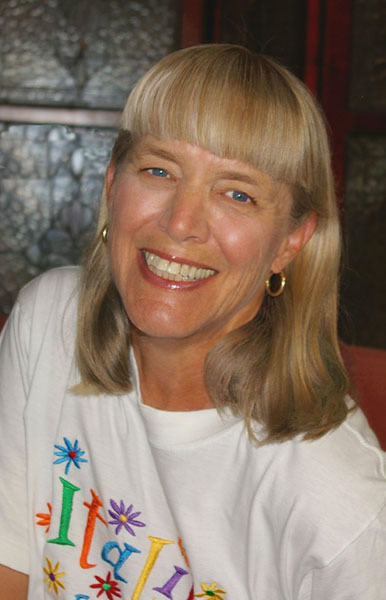
Noelle Soren
My youth was spent in St. Louis, Missouri at Wright Elementary School and Horton Watkins High School (Ladue) where I sang with the High School Chorus and the All County Chorus. In the Fall of ’63 I entered college at Central Methodist College in Fayette, Missouri to major in Spanish, a subject I had loved in high school due to my wonderful teacher, Miss Medina – my fiancée Bob was already there (a guy I was dating from Kirkwood High). I was fortunate there – I continued singing at shows and studied hard and was named as one of their 1964 Coronation Ball Queens (Queen of Beauty) with Bob at my side.
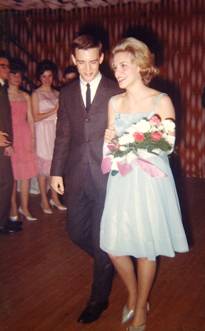
I soon realized, however, that Central’s Spanish program did not have the depth I needed – and I found a new and broader interest in Anthropology and especially Archaeology – in truth I had always been fascinated by Greek, Roman and Egyptian archaeology since childhood and so I decided to take the plunge and really try to be an archaeologist. As it turned out one of the very best programs in the USA in Classical Archaeology (the archaeology of ancient Greece and Rome) was at the University of Missouri in Columbia with a Professor named Saul Weinberg! So my junior year I transferred to study ancient Greek, Anthropology and Greek and Roman Archaeology. I applied to live in the first coed dorm on the campus, Mark Twain Hall. After I was mistakenly assigned a room in the male wing, and after I was sent literature from the army, navy and marines urging me to enlist (women did not serve in those days, remember?) I decided there must be a problem with my name – Noel is after all a male name, like Noel Coward. So I changed the spelling to Noelle. My roommate was the best! - Margie Agatstein (now Weiser) from Long Island, New York).
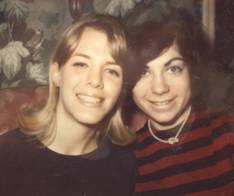
Margie and me
That summer I went on my first dig – at a small Colonial/Native American site in Miami, Missouri – to learn technique.
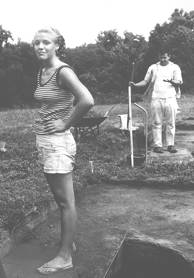
Yikes! In all fairness you have to know that the hole behind me is a 19th century latrine that I had just finished digging – this was almost enough to get me out of archaeology – but I knew that this area was just too …recent! I knew that things would be different if I could dig a Greek or Roman latrine so…
My senior year a kind professor recommended me for a summer project digging Roman remains under Winchester Cathedral in Winchester, England. I intended to return to Mizzou grad school in Classical Archaeology that fall after I graduated (Phi Beta Kappa , B.A. Magna Cum Laude in Anthropology). It was about then that I told Bob that I planned to go to graduate school and wanted to be an archaeologist and that I wanted to wait to get married. He said he had no plans for graduate school and didn’t want me getting more degrees than he had! But we were still engaged as I was off for my first trip to Europe! The Winchester team was made up of over 250 students from all over the world.
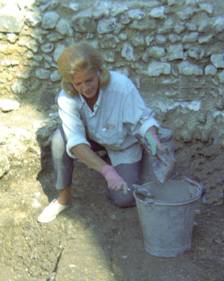
Digging in the Roman stable at Winchester
The second day I was there I was assigned to dig an ancient Roman stable beneath the rose garden of the house of the Bishop of Winchester, next to the Cathedral. As I waited with the group gathering for the first day of work (June 25, 1967) I saw him – David Soren, from Dartmouth College – and he saw me - and it was absolutely love at first sight!! It really does happen – neither one of us could believe it either! Problem – we were both engaged! The third day we wrote the good-bye letters to our respective fiancées and spent the rest of the summer planning how to tell our parents, how we would spend the rest of our lives together, and how we could get married as soon as possible!
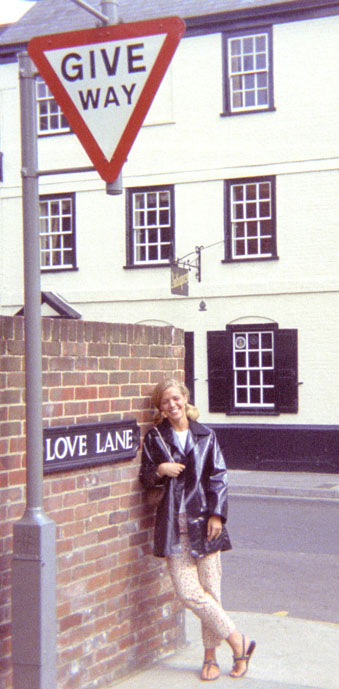
In Salisbury, England - we thought these two signs were a funny play on words!
We tried – (ahh – the ‘60s!) in Paris we were told we had to hire lawyers – in Spain we had to be Catholic (we’re not) and in England there was an annoying waiting period of several months and residence requirements.

Our engagement picture with cake at dinner in Winchester
So we waited – and on December 22, 1967 we were married in St. Louis and drove off to Dartmouth where David was finishing his senior year in Classics (Greek and Latin).

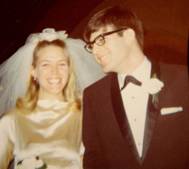
New Mr. and Mrs.
Our honeymoon was simply driving across the country – but we suspected (and we were right!) that the rest of our lives would be an endless honeymoon! We decided that David would finish his last year at Dartmouth, then do graduate school, I would work and we would dig together and later I would return to graduate school. Looking back on it now I can hardly believe that it worked out just like that! So I got a job in Hanover, New Hampshire and at night I sang with David’s psychedelic rock band, Sphinx, at fraternity parties and such. David wrote their music and played the lead guitar – they were quite good really and even made a record (you remember those vinyl things?), but when Harvard offered David a scholarship for their Classical Archaeology degree after he graduated from Dartmouth (they only accepted 3 a year and I think that may still be the case) he had to take that incredible opportunity.
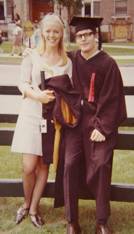
David’s graduation from Dartmouth
Now, when you are a graduate student in Archaeology the one thing you have to do is …DIG! So right away we were off to Turkey, to the site of ancient Gordion near Ankara where we spent the summer of 1969 digging with a team from the University of Pennsylvania with the famous archaeologist, Rodney Young.
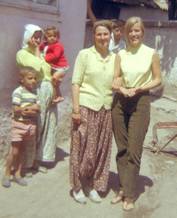
With the family of our pickman, Omer Tokat, at Gordion in Yassihüyük, Turkey
The work was hot, hard and primitive – no extra water for showers, lots of mosquitoes, vermin, the cook inadequate, the food suspect and often contaminated, many were sick with “Turkish Tummy” (a sort of salmonella with a dash of dysentery) almost constantly, including us. Young believed in roughing it to the extreme and tolerated no complaining. I lost 15 pounds and was so glad to see September – but it turned out to be a good thing. It gave us impeccable dig credentials for our next step and taught us both how NOT to run an excavation AND it showed me the absolute importance of healthy food, leading to my obsession with gourmet cooking. We took the Orient Express on the way home from Turkey - the real one, not the ersatz modern version– Istanbul to Paris – remember From Russia With Love? It was just like that – minus Sean Connery!
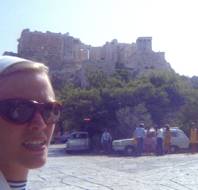
When the train stopped in Athens for some hours we jumped off and went for our first visit to the Acropolis.
Back at Harvard, the word was out that the Smithsonian was beginning a large multi-year project in Tunisia on the coast of North Africa (just south of Italy) to catalog all of the thousands of visible Roman mosaics in the country before they were destroyed by the rapid urbanization there. We were invited and jumped at it! For the next 6 years were worked and lived all over Tunisia – from Tunis to Utica to Carthage to Zaghouan to Thuburbo Majus to El Djem – and published many volumes of the Corpus des Mosaiques de Tunisie (still available on Amazon!). Winters were spent at Harvard preparing for the next season. It was on these digs that I learned museum conservation and archaeological drawing.
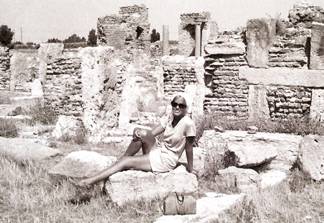
Among the ruins of Sbeitla, Tunisia about 1970
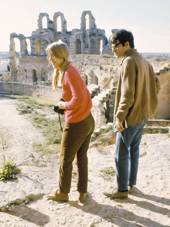
At the amphitheatre at El Djem, Tunisia
(Oh – we were actually in the movie Love Story – a scene in a snowy Harvard yard with lots of students walking back and forth! We were on our way to the library and the directors just told us to keep walking while they kept filming – no pay of course!)
Since my jobs were all connected to Harvard, they were very generous in allowing me to have leave for my job as staff artist and museum conservator in Tunisia from February to September in 1970-72 and the summers from 1973-1977. We lived in hotels and apartments and enjoyed the local cuisine and the fabulous shopping in the souks of Tunis where we started our collections of North African rugs and Berber jewelry. We traveled all over North Africa in those years, from Morocco to Egypt and all stops in between!
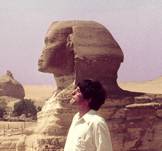
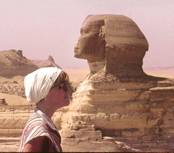
Comparing profiles with the sphinx at Giza
Most interesting to be in Libya in just after Ghadaffi took power!
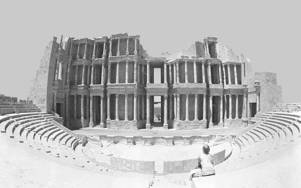
I am staring at the Roman Theatre at Sabratha in Libya
And on our trips to and from we always stopped in Paris for a week or so.
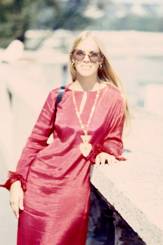
On the Pont de la Concorde in Paris about 1972
And often we stopped in London, since we had a special fondness for England as the place we met. Since he was a boy, David has been a lover of horror movies - and those made by the British Company Hammer Films were special favorites of his. So one day we went to Hammer - we just walked right in a announced that we were publishers of a fanzine (fan magazine) about horror films in the U.S. and we asked for the addresses and phones numbers of David's favorite Hammer stars so we could intervew them - and we got them!! So for the next couple of years, whenever we were in London, we sought out and interviewed stars like Christopher Lee (Hound of the Baskervilles, Man with the Golden Gun, Horror of Dracula, Dracula Has Risen From the Grave, Lord of the Rings, etc... ), Peter Cushing (Curse of Frankenstein, Star Wars, Horror of Dracula, The Beast Must Die, Frankenstein Must Be Destroyed, She, The Gorgon, etc...), Andre Morell (distinguished Old Vic Shakespearean actor and featured player in Bridge on the River Kwai, She, The Mummy's Shroud, Hound of the Baskervilles, Ben Hur, etc...), Joan Greenwood (Tom Jones, Mysterious Island, Hound of the Baskervilles and countless British TV roles), Michael Gough (all the Batman movies, Curse of the Crimson Altar, They Came from Beyond Space, Berserk!, and many British TV roles) and Michael Ripper (perennial Hammer character actor in films like The Mummy, Curse of the Mummy's Tomb, Plague of the Zombies, The Mummy's Shroud, Taste the Blood of Dracula).
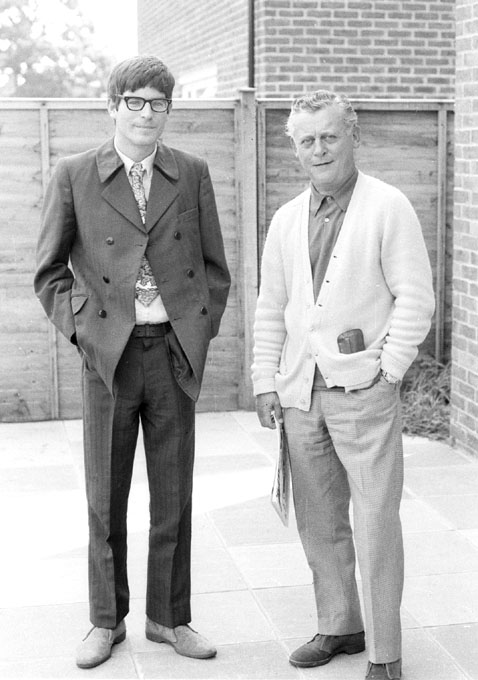
David and Michael Ripper about 1972
To keep us honest, David had to actually produce the fanzine where these interviews were published, and so he wrote and distributed Fantastic Worlds Magazine, Issues 1 and 2, a real collector's item today!
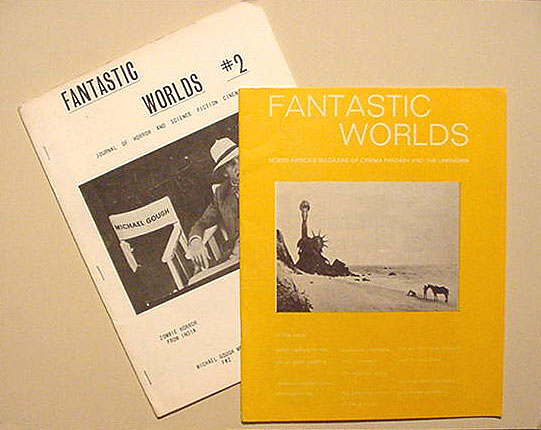
David got his Ph.D. in 1972 and realized it was time for a real job! The best place looking for a Professor of Archaeology that year was….the University of Missouri! So back we came and all of my former profs were now colleagues – it was strange for a while. We bought our first house and continued working in Tunisia taking Mizzou students to learn digging techniques in that exotic country. In the mid 1970s we added another project to our work – a world-wide effort led by UNESCO to save the ruins of Carthage (Tunisia) from urbanization. There we worked with Larry Stager of the Oriental Institute, University of Chicago. It was with Larry that I really learned to do archaeological drawings of the hundreds of burial urns we found with the charred remains of the Carthaginian’s infant sacrifices.
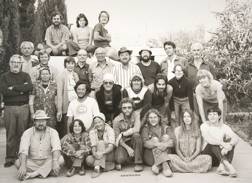
With Larry Stager (first row, far left with hat) and the team in Carthage, Tunisia.
We are on the far right.
It was at this time that I returned to graduate school in Art History and Classical Archaeology at Mizzou. And David was ready to get a dig of his own, though we had loved, absolutely loved!!, our work in Tunisia, he wanted to have his own dig and be the boss. We had an opportunity to dig in Portugal through a professor at the University, so off we went to Santiago do Cacem in southern Portugal to dig in the remains of the Roman town of Mirobriga.
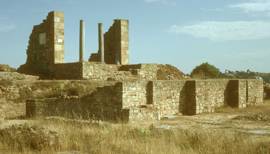
The Capitolium and Forum at Mirobriga
Several seasons there taught us to love Portugal too, especially the cuisine. One season in a weak moment I agreed to be the cook for the team (the first and last time!) and learned to produce a scrumptious lunch for 20 with one hot plate and no refrigerator (we shopped for fresh at 6:00 each morning in the local market). It was way too difficult!
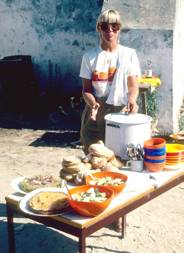
My “kitchen” - Simple soups and stews – but we did eat well!
But we never forgot Turkey – so we all lived in comfortable hotels and ate luscious local fare in the evening at local restaurants. (Our digs are now well known for our attention to comfort and healthy food for our teams – unusual in the world of archaeology!) Meanwhile, Larry Stager, our friend from Chicago, ended his Carthage dig and moved his operations to the island of Cyprus and sorely needed an artist. So I took the job with the plan of finding a great site for David in Cyprus (since our work in Portugal was winding down) – one with a good hotel nearby for our team, good restaurants and a beautiful beach for fun. I traveled around the island with Larry’s team and found the perfect place – ancient Kourion (Curium) on the beach at Episkopi in the south.
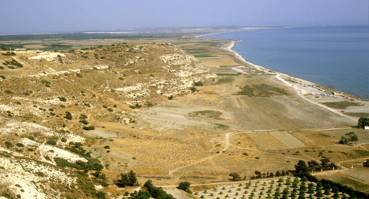
Kourion cliff, where the site is located, juts out toward the Mediterranean in the top center of the picture.
As luck would have it, Larry was buddies with the Director of the Antiquities Department and so I met him and told him that David and I were free and had a great idea for a program of digging at Kourion, though in truth I had only just heard of that beautiful site.He had heard of our work in Tunisia and Portugal, and so was glad to invite David for an interview! A couple of weeks later David came to visit me – I gave him a book on Kourion and showed him the beach and - he’s a quick study - by the time he met the Director he had a great plan for excavating the site and got his permit to dig! We worked at Kourion for several seasons concurrent with our work in Portugal and published several books and articles, among them Kourion: The Search for a Lost Roman City (still for sale on Amazon!)
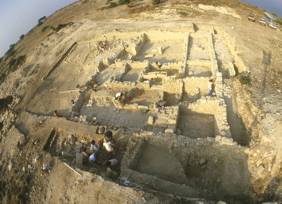
Digging in one of the houses on Kourion cliff. I took this perched in a “cherry picker” – you can the shadow of it (and me) on the right.
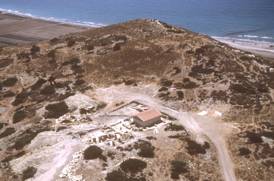
The top of Kourion cliff with the sea below. The red roof covers a small museum that we built over the house being excavated in the previous picture
In the late 1970s I finished my graduate study in Art History and Classical Archaeology with a special emphasis in the history of architecture. Thanks to my degrees I got a job right away with the State of Missouri Office of Historic Preservation in Jefferson City as an Architectural Historian. (Hated that commute!) My job was to research buildings and write nominations for the National Register of Historic Places. I had this job for 5 years (when I wasn’t digging) and I am proud to say that my work helped place several important historic buildings and districts on the Register, including Frank Lloyd Wright’s Pappas House in St. Louis, the Fox Theatre in St. Louis, Des Peres Presbyterian Church in Des Peres, the Missouri Theatre in Columbia, the Missouri Theatre in St. Joseph and the District of Florissant in St. Louis.
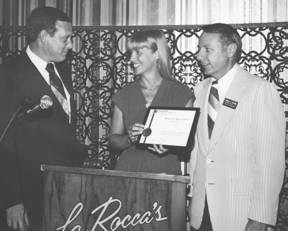
The ceremony making Florissant a Historic District
As part of that job I won a scholarship from the Smithsonian to attend ICCROM (the International Centre for the Study of the Preservation and Restoration of Cultural Property) in Rome, Italy for 7 months in 1980 (http://www.iccrom.org/) where all of Italy was our laboratory to learn techniques for repairing and restoring historic buildings to keep them in harmony with their histories and surroundings.
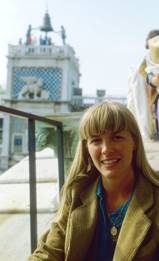
On an ICCROM class trip to Venice, on the roof of St. Mark’s Cathedral
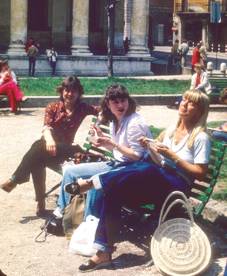
Lunch and sun with my best buds Aydan Hacagloglu (Turkey) and Simonetta Bennetti (Italy)
on an ICCROM trip to Vicenza, Italy
Actually we also learned a lot about construction – it was so much like going to architecture school that, a little while after my return, I found a better job as a Building and Housing Inspector for the City of Columbia. This was quite a big deal as they had never had a woman pass their construction test before! So I was the first female inspector to work in that office. They were also very generous with vacation time for my work in Cyprus. In connection with my interests in architecture and architectural history, I researched and wrote an exhaustive study of the Boller Brothers Architects, well known Missouri theatre architects who designed theatres throughout the Midwest and western United States. The book, Windows to Wonderland: The Cinéspace Creations of the Boller Brothers, Architects, can be found in public and university libraries throughout Missouri, Kansas and California.
In 1977 one of David’s profs from Harvard published an article by another Harvard professor, based on research that David had done as a student but without giving him any credit. What a scandal!! David’s professor had not been aware that the author stole David’s work and was so upset that, to make amends, he offered David the job of lecturing on a 3 week cruise to the Greek Islands with the American Museum of Natural History in New York that he was supposed to do. That was the first of over 30 trips and cruises all over the whole of Western Europe and the Greek and Roman world from Morocco and Spain, to the Black Sea and the Balkans, Greece and the Islands, to Syria, Jordon, Turkey and Israel, across all of North Africa, and on to Yemen, Oman, Saudi Arabia and India that we have been privileged to lead as lecturers. We have worked in this capacity for Swan’s Hellenic Cruises, the Sea Goddess Line, Renaissance Cruises, the American Museum of Natural History in New York and the Archaeological Institute of America among others.
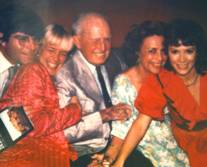
Here we are on a cruise From Venice to Athens – Jack and Frannie, the couple in the middle, were in their 80’s and celebrating their first wedding anniversary! The woman on the right is Sharon Gabet, who played Raven in the soap, Edge of Night
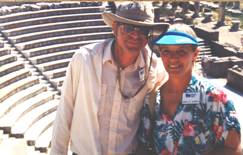
In the theatre at Dougga, Tunisia with a tour from the American Museum

A brochure for one of our tours
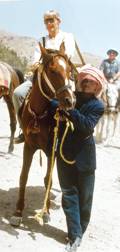

Heading for the Siq at Petra, Jordon. This incredible site can be entered only through a narrow
passage called the Siq by horseback or by foot.
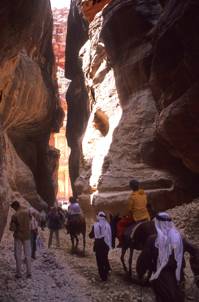
Riding through the Siq at Petra, Jordon
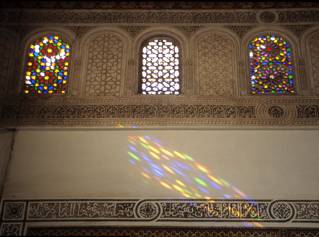
Inside a mosque in Marrakesh, Morocco
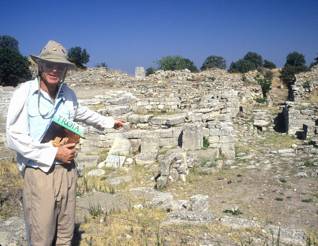
In the complex ruins of the city of Troy in western Turkey, David is pointing out
some of the ruins of Troy VI, the Homeric city of the Illiad
In 1982, David got an offer to come to the University of Arizona to build a Classical Archaeology program within the Classics Department. Arizona was kindly disposed to archaeology already as it is the home of the best U.S. program of American archaeology in their Anthropology Department. So we made the big move to Tucson, Arizona (with leave for 2 cruises per year written into his new contract!) I was thrilled to move to such a beautiful place – we live north in the foothills of the Catalina Mountains where the landscape resembles the semi-desert areas of Tunisia near the Sahara where we spent many happy years.
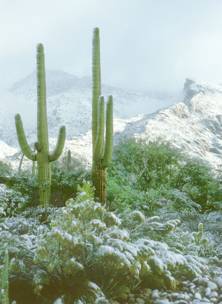
A rare sight here - snow! Our front yard in Tucson looking toward the Catalina Mountains
Once in Tucson, rather than look for an office job, I decided to try some things I had always wanted to do. I attended a cooking school and received their Premiere Diplôme Culinaire. With that I opened a small catering business, The Pampered Palate, specializing in intimate dinners for up to 8 people, and I also became a teacher at that school, specializing in soufflés, quiches, breads and herb cookery. My classes and my herb garden were written up by the local paper.
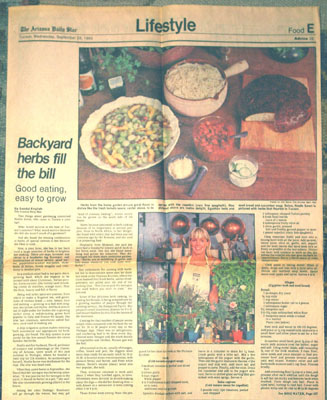
From the Arizona Daily Star
I also worked as a professional pastry chef for local restaurants with specialties such as Lemon Tart Brulée, Chocolate Grand Marnier Torte, Double Chocolate Torte, Rum Baba and Kourabiedes (Cypriot almond wedding cookies) (all pictured in order below).
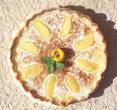

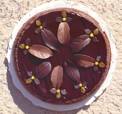


After we moved to Arizona, we began to feel an empty space in our lives – we longed for the patter of little feet – so along came our first-born – we named him Elagabalus Apollo, Duke of Kourion (it’s a joke! a funny name if you are an archaeologist!) but we called him Digger.
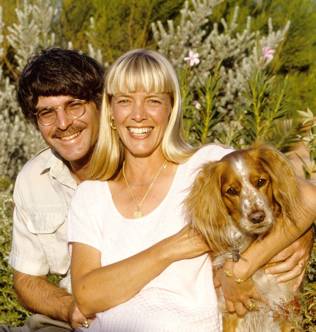
With our cocker spaniel, Digger
Meanwhile we continued to work at Kourion and Mirobriga, taking Arizona students as our digging team. One of my jobs had long been that of the staff illustrator.
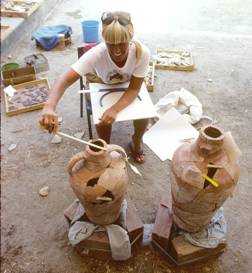
First the conservators mended the pots (we called the “pots in bondage”)
and then I drew them
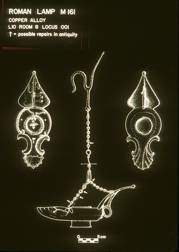
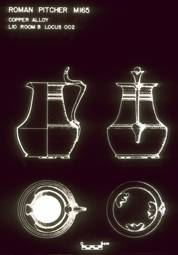
Two of my publication drawings of objects from Kourion
Click here for a larger version
But a problem developed. David had a hard time finding and keeping photographers. Archaeological photography is specialized work and since archaeological digging is basically the destruction of evidence in an orderly way, photographs are essential at each stage as the only record left of evidence. Simple put, you dig to a level, clean it up, photograph it, draw it and then…RIP IT OUT! Then it is gone and lives on only in photos and drawings, essential for further study. In addition, in those days before digital, all film had to be developed each day to be sure the evidence was recorded properly before digging could continue. In the case of Kourion, that meant learning to develop color and black and white in a bathroom sink with little equipment but your own wits and then printing the negatives to make the prints for publication. Very demanding work in primitive conditions – no Fotomats! David fired 6 photographers in the first 2 years at Kourion – I knew exactly what he wanted but, except for being a shutterbug, I knew nothing about photography – so I decided to take it on. I took a photography course at the University - a special course in Scientific Illustration and Photography meant just for scientists and archaeologists – a wonderful course that I actually ended up teaching for 3 years teamed with the professor.
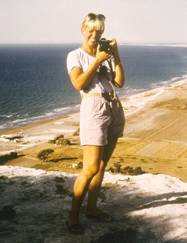
Photographing on Kourion cliff overlooking Episkopi Beach
Meanwhile, at Kourion we made incredibly important discoveries that changed the way Mediterranean history was written. We found evidence for the great earthquake of AD 365, a quake reported in literature of the time but never seen in evidence until we uncovered a neighborhood full of skeletons - people caught unaware by the quake that had decimated this part of Kourion – so much so that people were afraid to come back and it was never rebuilt. We knew the date of the disaster because the Emperor Valens had the courtesy to arrange his coinage in two very different styles in the very year of the quake and we found both types in secure contexts.
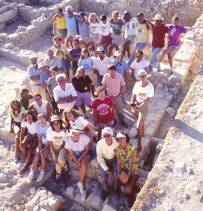
One of our teams at Kourion - Sorens are at middle right
Careful digging revealed the city before this quake and after with these coins of 365 AD as markers – an archaeologist’s dream – we made headlines all over the world. The National Geographic covered it in their July, 1988 issue with an article by David,“The Day the World Ended at Kourion”. I know some of you have seen my picture of skeletons of three of the quake victims as it was published in literally hundreds of magazines and papers in the mid-1980s– a mother cradling an infant in her arms (its tiny skull is just in front of her face), being protected by the husband with his leg over the mother

The mother, right is cradling the tiny child in her arms while the man tried to protect them both from the falling debris that broke her neck and killed them all.
This picture was so popular and touching that it has been stolen at least twice by tabloids. The first time, the Sun used it with the headlines “Adam and Eve discovered in Colorado”! and again a few years later by the Weekly World News as “The Bible’s Garden of Eden Discovered in Syria –Adam & Eve’s Skeletons Found”. You may have seen those at the supermarket – evidently they failed to noticed the tiny infant skeleton barely visible in the mother’s arms – was it Cain or Able?!
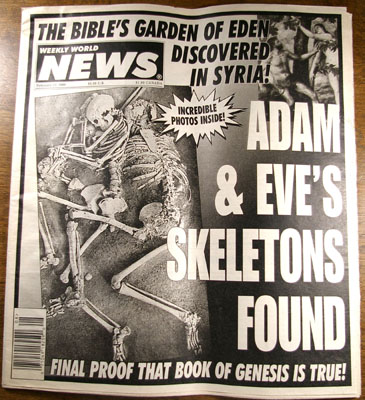
Our work at Kourion was dangerous in that period – the mid 80s was a time when hijacked TWA or Lufthansa airliners seemed always to end up in Larnaca, the main airport on Cyprus. Our site was just off a major British air base at Episkopi, and we learned that one of the Lebanese terror groups had set up camp near Limmassol just down the road. The British commander told us that we, as Americans, were under surveillance by this group so they gave us protection and one of their officers became a member of our team.
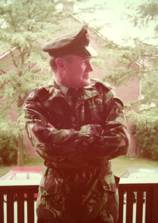
Warrant Officer Harry Heywood, from Episkopi Base, an amateur archaeologist who worked
with us in Cyprus and for many years in Italy too
He taught us to bomb check our car every morning, and became a valuable member of that team and many others in later years. Thankfully we had no trouble. But just after we left our site in 1987 there was a mortar attack on Episkopi Beach that actually killed several tourists.
Quality archaeological work is always expensive, so much of our time has been devoted to fundraising. All of the funds are used to do scientific research or to fund the students who work on our excavations for academic credits. We have never taken a salary from the money we raise. Over the years we had many friends and acquaintances generously give of their time and talents to help us raise the funds for our many projects. A few well remembered are Lew Ayres, fine actor in such great movies as Dark Mirror, All Quiet on the Western Front, Johnny Belinda and the Dr. Kildare series; Tony Franciosa, star of such great films as Tenebrae, Death Wish II, Period of Adjustment, Hatful of Rain and Face in the Crowd and many fine TV dramas; Loreena McKennitt, noted musician and composer of Celtic music, with hits like The Mummer’s Dance from her CD The Book of Secrets, and Gold, Platinum and Multi-Platinum Awards from all over the world; Harry Lange, production designer of such great films as 2001: A Space Odyssey, Moonraker, The Empire Strikes Back, Dark Crystal and Monty Python’s The Meaning of Life; the Dixie Chicks, 13 time Grammy Award winning country/rock group; Jane Wyatt, star of films like Lost Horizon of Shangri-La and Gentlemen’s Agreement and TV shows like Father Knows Best, Startrek and St. Elsewhere; Billy Wilder, Academy Award winning director/ writer of films like Sunset Boulevard, The Apartment, and Lost Weekend; Robert Wise, noted director and producer of movies such as Star Trek: The Motion Picture, The Sound of Music, West Side Story, The Haunting and Andromeda Strain; Russ Tamblyn, dancer and star of movies like West Side Story, Peyton Place, Wonderful World of the Brothers Grimm, Tom Thumb and TV shows like Twin Peaks and General Hospital; Norman Lloyd, famous producer, director and actor in such great films as Saboteur and Spellbound (both by Hitchcock) and in numerous TV productions, including many episodes of The Practice, St. Elsewhere and Murder She Wrote.
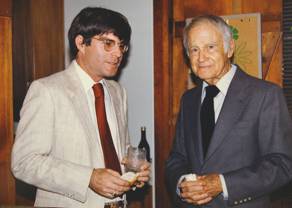
David and Lew Ayres at a benefit showing of his award winning film, Altars of the World
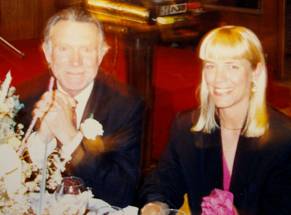
At a fundraising dinner with Tony Franciosa
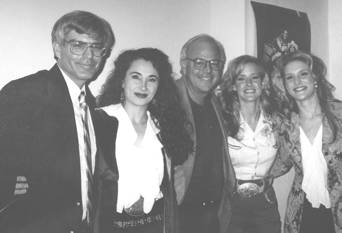
David and our friend Dennis Evans with the original Dixie Chicks, Laura Lynch, Emily Robison and Martie Maguire
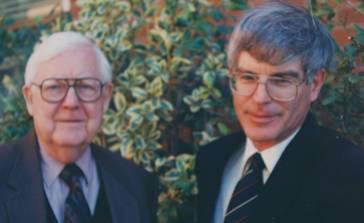
David and Robert Wise
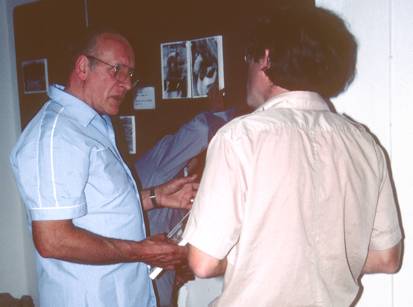
David (right) and Harry Lange, working on the design for our small museum in Santiago do Cacem, Portugal

David with his web assistant along with Russ Tamblyn and his wife, Bonnie
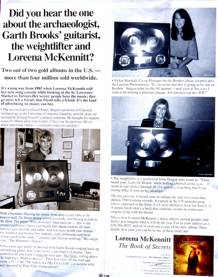
David (left photo), a recipient of a gift of gold records from Loreena McKennitt of “The Visit” and “Mask and Mirror” poses with them for a publicity photo for her release, “The Book of Secrets”.
About this same time our dig at Kourion came to the attention of Discover Magazine, so they sent a writer, Jamie James, to do an article about our work (“New Ways of Looking for the Past”, Discover Magazine Sept. 1986). It’s full of great photos and drawings showing the importance of the 365 AD earthquake and the site of Kourion.

David in a photo from the Discover Magazine article posed with some of our movie memorabilia collection.
Our Kourion work brought us to the attention of antiquities services all over the world – as we came to the end of our excavations there, other offers came in – the one we accepted was an offer to dig a Roman Villa near Lugnano in Teverina, in the countryside of Umbria in Italy, north of Rome. After several seasons of digging we unearthed a beautiful Roman villa of the first century AD. On the south side overlooking the Tiber a part of the villa (by then in ruins) had been used as a cemetery for infant malaria victims in the 5th century AD. This is one of the largest villas ever discovered in Italy (about the size of our largest shopping mall) and by far the best preserved infant cemetery known in the Roman world. After groundbreaking DNA studies the infants were shown to have died from malaria. This, along with literary evidence, supports David’s rather radical theory that malaria was a root cause of the decline of the late Roman Empire. His theory caused a lot of controversy in the field of archaeology at the time, though it is now accepted as fact. A special about it was featured on the Discovery Channel and another for the BBC series shown on the History Channel, Meet the Ancestors “Malaria and the Fall of Rome” that is still being shown now and then. Once again one of my photos, an infant skeleton found buried in an amphora (storage jar), was seen in papers and magazines all over the world.
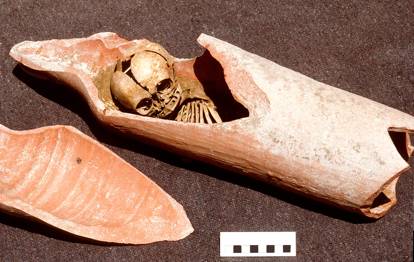
The storage jars were used as caskets for the tiny newborn and prenatal victims of malaria. The scale is in centimeters.
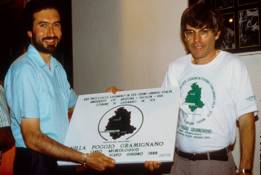
David, receiving a marble plaque honoring our dig from Claudio Finistauri (President of the Associazione Pro-Loco di Lugnano), at the ceremony where he was also given honorary Italian citizenship.
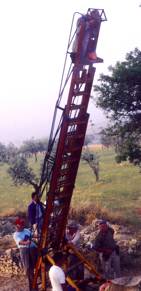
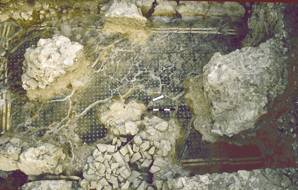
Here we used the local fire department’s ladder get enough altitude to produce the publication photo above of a mosaic floor damaged by the collapse of the first century villa.
In the 80s and 90s, though we were not working in Tunisia any longer, we still made frequent trips there leading tours and cruises for the American Museum of Natural History in New York and the Archaeological Institute of America. We became close friends with the Director of the American Museum, Dr. Thomas Nicholson.
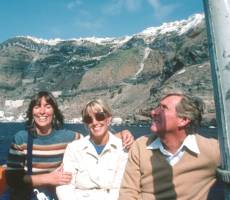
With Tom Nicholson and his daughter, Diana, on a tender heading to the island of Thera
One day when we were all at the famous Bardo Museum in Tunis, Tunisia he decided that David should launch and curate a show that would bring the incredible Roman mosaics from the Bardo Museum to New York. After 8 years of negotiations and many trips for us back and forth to Tunisia, the show opened in New York to rave reviews and traveled for the next several years around the USA and Canada. This also was accompanied by a documentary, this time made by David for PBS, and the Catalogue, Carthage: A Mosaic of Ancient Tunisia.
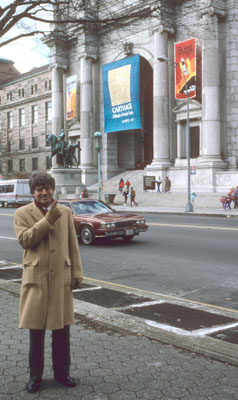
After 8 years of work, David pointing proudly at the banner for his Carthage show at the American Museum of Natural History in New York.
David and I wrote our magnum opus on Lugnano, A Roman Villa and Late Roman Cemetery at Poggio Gramignano, Lugnano in Teverina Italy in 1998 (all yours on Amazon for just $608!).
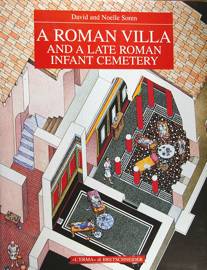
In the early 90s we wound up our excavations at Lugnano and got invited to dig a site up the autostrada in Tuscany at a place called Chianciano Terme –a town of modern spas.

On site in Tuscany
Their local archaeological club had found a large ancient pool and needed our expertise to dig it, since it was at the level of the water table and constantly flooded. After several digging seasons we again made headlines by combining literary and archaeological evidence to discover that this pool was part of a large spa where the Emperor Augustus had come seeking a cure for a mysterious illness of the digestive tract discussed by the Latin author Horace. We found the sources of the ancient spa and analyzed the water. The Emperor must have been suffering from constipation because the chemical composition of the water from our spa is one of the most powerful laxatives known. With that discovery we made headlines in the New York Times (John Noble Wilford, “Did Augustus Take the Waters Here? Ruins Hint ‘Yes’”, New York Times, Science Times June 16, 1998, F1) and papers all over Europe.
You can read more about this site in the New York Times Archives.
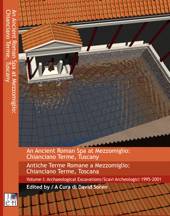
Our first volume on this site, An Ancient Roman Spa at Chianciano Terme, Tuscany Vol 1: 1995-2001 has recently been published in the BAR (British Archaeological Reports). We are continuing to work there as we prepare our second volume on the site.
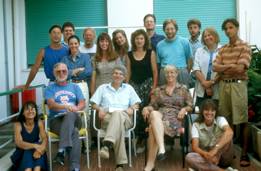
One of our recent groups at Chianciano Terme – that is a bearded Harry Heywood seated left of David
So we have been excavating and publishing together for over 40 years. We are one of the few long term American couples teamed up in classical archaeology today – there just aren’t many others because the work is hard, dirty, sometimes dangerous but always exotic and thrilling, and demands total dedication to it and to each other.
In 2001, David decided to open a fully accredited Institute in Orvieto (in Umbria north of Rome) connected to the University of Arizona to enable his students to get study abroad credits in art history, classics, art and related subjects as well as archaeological experience at his dig and others in the area. After much diplomacy the school opened and can be read about here:
It is a fabulous opportunity for any college student.

The Institute is housed in the building in the center of the picture, just next to the
extraordinary Cathedral of Orvieto on the left.
So at present we spend part of the year in Orvieto teaching the students at the Institute and part in Tucson where David is the Regents’ Professor of Classics and Classical Archaeology at the University of Arizona. Digger and his little sister, Angel have passed on but we have Lana now who has a special permit to attend all classes and meetings at the University.
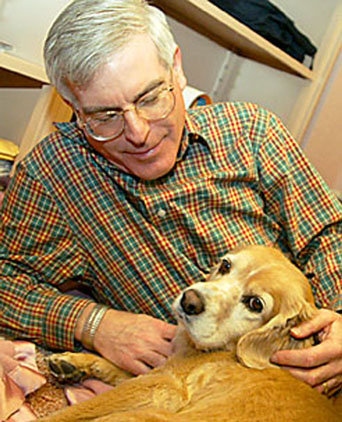 ................
................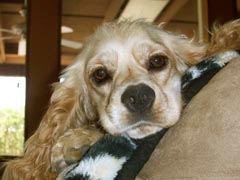
David and Angel.............................................................Lana
When we are not digging or working in Orvieto, I devote my time to converting our 8000+ slide collection to digital images for our Powerpoint presentations and to collecting vintage ladies compacts – Fabergé (the Russian jeweler), Cartier, Salvator Dali, Tiffany etc. from all over the world. I have an extensive collection of 700+ and recently the University Art Museum put on a show of them, The Art of Allure, for which I wrote the catalogue and did all the photography. I have seen it available on Ebay from time to time.

The front cover of the catalogue for my show
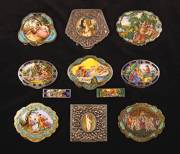
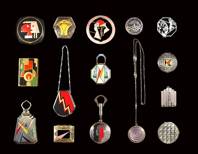
A few rare Italian enamels (left, some with matching lipsticks) and a few Art Deco and
Cubist examples (right) from my collection
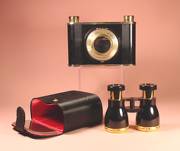

(Left) Whimsical novelty compacts shaped like a camera and pair of binoculars from my collection. (Right) This is the ultra- rare “Bird in Hand” compact by Salvador Dali from my collection
Click here to see the catalogue for the entire compact collection
Click here to read about the beautiful and rare Italian 800 compacts
Click here to learn about fine compacts as works of art
In addition, we have a modest business on Ebay selling primarily ladies compacts, sheet music and movie memorabilia. To see what we are selling today click here ![]() . We are currently researching (in addition to our next volume on Chianciano Terme) the pre-Christian topography of the Vatican area. Most recently, we both worked on several episodes of Where Did It Come From, a 2007 series for History International. David is interviewed in several episodes about the ancient origins of concepts like sports stadia, bathrooms, fire departments, apartment complexes and other topics.
. We are currently researching (in addition to our next volume on Chianciano Terme) the pre-Christian topography of the Vatican area. Most recently, we both worked on several episodes of Where Did It Come From, a 2007 series for History International. David is interviewed in several episodes about the ancient origins of concepts like sports stadia, bathrooms, fire departments, apartment complexes and other topics.
My hobbies/interests include the topography of ancient Rome; time, entropy, entanglement, the Higgs boson, string theory, M theory (Branes, parallel universes) and quantum gravity; comets asteroids and catastrophes; walking (4-5 miles a day); the movie theatres by the Boller Brothers Architects; and 9-11 facts and fantasies. If and when we retire we will keep on doing exactly what we are doing now!....but we do have our eyes on a lovely villa just outside Chianciano in the heart of Tuscany.